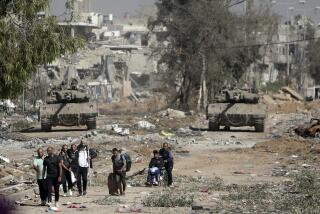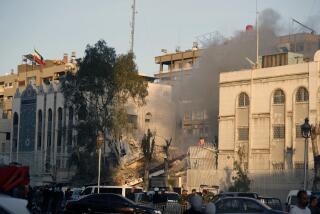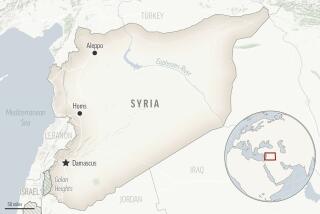At border, Israelis watch Syria’s civil war through a fortified fence
SYRIAN BORDER, Golan Heights — From the bunkers and watchtowers along this tense, fortified frontier, Israelis say they can do little more than view from afar the civil warfare raging across the border in Syria.
And in a reminder of the helplessness and paralysis felt by the international community over what to do, Israel’s most visible strategy seems almost futile: It’s building a fence.
With 20 feet of steel rebar, the structure is much taller and more imposing than the flimsy barbed wire coils and rusting posts that once separated Syria from Israeli-occupied Golan Heights.
Underground sensors detect infiltration. Cameras monitor all activity. Military contractors, working day and night for the last few months, have completed 50 miles of the planned 65-mile barrier that will line most of the border with Syria.
But it’s still just a fence. Near the Syrian government-controlled village of Madariya, Syrian intelligence officers and Israeli soldiers are so close that they can eye one another without binoculars.
Errant mortar rounds occasionally fly over the long-quiet border and land in Israeli military camps or settlements. Hundreds of wounded Syrian fighters have limped to an Israeli military hospital on the border seeking treatment, and seriously wounded Syrians are sometimes treated in Israeli hospitals nearby.
Most recently, the fence created security and humanitarian challenges when hundreds of refugees began setting up camps on the Syrian side, betting that combatants wouldn’t attack them so close to Israeli military positions.
In the rustic Israeli development of Alonei Habashan about a mile from the border, about 300 Jewish settlers try to make wine and harvest walnuts as usual, but residents say their idyllic lifestyle has been shattered by the sounds of distant gunfire and explosions.
“We’re drinking wine here and there are bombs on the other side,” said Yaron Dekel, 37, a biochemist who lives with his wife and 1-year-old daughter. “It’s a pity.”
Like much of the world, Israel is unsure of how to react to a conflict that the United Nations says has killed more than 100,000 people and involved the use of chemical weapons.
Officially, the Israeli government says it’s not taking sides, though several Israeli officials have said that Syrian President Bashar Assad must go.
Once viewed by Israel as a predictable enemy and paper tiger, Syria has created new worries with its chemical weapons and close ties to archenemy Iran. Many Israeli leaders have concluded that the region would be safer without Assad, even if that meant Islamist radicals would take over.
But Israel has vowed to stay out of the conflict as long as Assad does not try to transfer advanced weapons to Hezbollah, the Shiite Muslim militant group based in Lebanon that has entered the war on Assad’s side. Four times this year, Israel has bombed weapons caches that it believed were about to be transferred to Hezbollah. But it has avoided any direct strikes against Assad or his forces.
Instead, the military has watched with growing anxiety as the fighting grows more intense near the Golan Heights, which Israel seized from Syria during the 1967 Middle East War.
Israelis say they can barely keep up with the players as rebels and government forces fight for control of strategically located border towns, including Madariya and Quneitra.
Rebels frequently attack Madariya in hope of using it as a launching pad to seize Quneitra, a symbolic and strategic government stronghold, says Brig. Gen. Gal Hirsch, an active reservist in the Israel Defense Forces and a former commander of Israel’s 91st Division in the north.
Not far away, rebels recently seized Bir Ajam, a Circassian village. A little farther southeast, near the intersection with the Jordanian border, the villages are controlled by a different rebel group of Al Qaeda-inspired militants.
Maj. Gen. Yair Golan, head of Israel Defense Forces’ northern command, said in a recent interview with Yediot Aharonot that as many as 6,000 global Islamic militants are operating in Syria, infiltrating villages and quietly building infrastructure. Though the militants have refrained from aggressively attacking Israel, Israeli commanders see them as the greatest long-term threat.
“It’s just a matter of time before they attack Israel,” Hirsch said.
Hirsch is more concerned about Hezbollah, which he said is using the Syrian civil war to give its fighters battle training. In return for its support for Assad, Israeli officials say, Hezbollah expects to receive some of the Syrian government’s advanced weaponry, which it can eventually use against Israel.
“If it was not for Hezbollah’s help, the civil war in Syria would be over,” Hirsch said.
Tension between Israeli soldiers and Syrian government border forces is also rising, after years of relative quiet.
On a recent afternoon, a stare-down between Israeli ex-special forces commandos watching from a bunker and a lone Syrian intelligence officer on the adjacent hill ended with a crack of a Kalashnikov rifle from the Syrian side.
Hirsch said the biggest challenge for Israel right now is just keeping track of the various factions.
“The reality out in the field is changing so fast,” said Hirsch, who also works as a defense consultant. “We have to be ready for anything.”
More to Read
Start your day right
Sign up for Essential California for news, features and recommendations from the L.A. Times and beyond in your inbox six days a week.
You may occasionally receive promotional content from the Los Angeles Times.






